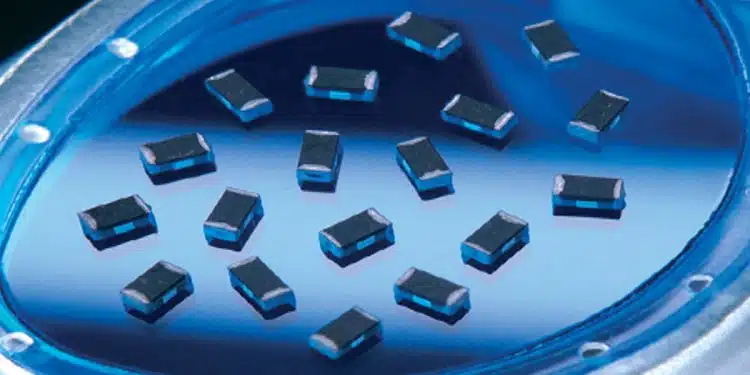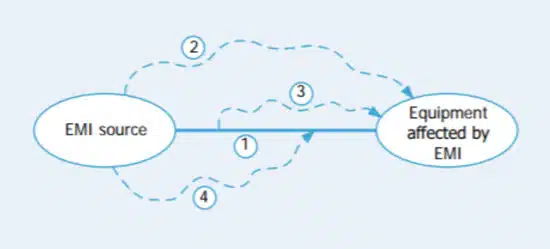This blog article by Knowles Precision Devices introduces EMI Filtering, EMI Filter, how it works and what is its performance.
With the ever-increasing use of electronic equipment comes a greater likelihood of interference from all the other equipment out there. In the same vein, we’re seeing more circuits, with lower power levels, that are easily disturbed; so, there’s a need to protect equipment from EMI (electromagnetic interference). In automotive or medical applications, for example, there can be no false alarms due to external interference. The level of uncertainty has pushed EMI compliance testing to the component level.
To meet international legislation such as the EU Directive on EMC or the FCC, EMI filtering is an essential element of equipment design. Introducing screening measures to case or cables, for example, may suffice in many instances, but you might need to introduce low-pass filtering for additional protection as well. Here, we will begin to explore EMI filtering and the terminology used in designing effective protection.
Input / Output Cabling
In an ideal situation, a Faraday Cage would protect a piece of equipment or circuit from EMI by totally enclosing it in a metal (or conductive box) and preventing interference. However, most pieces of equipment require input and/or output connections for power cables or signal control lines. The cables providing these kinds of connections can act as antennae that can pick up interference and radiate it, see Figure 1.
Subsequently, the following can occur:
- Interference can enter a piece of equipment directly through the cabling (conducted interference).
- Radiated interference can travel directly to the affected equipment.
- Interference can exit an EMI source via a cable, subsequently to be radiated from the cable and to the affected equipment.
- Interference can be radiated from an EMI source and then picked up by a cable entering the affected equipment.
Filter Location
Filter Location matters when it comes to preventing interference entering or leaving a piece of equipment. With Panel Mount Filters, feedback through EMI filters can be mounted in the wall of a shielded case, see Figure 2. All incoming or outgoing cables would then pass through the filters. Power, or any other wanted signals, pass through the filters unaffected, whereas higher frequency interference is removed. The screened case protects against radiated interference, and feedthrough filters protect against conducted interference. Combined, the integrity of the equipment is assured.
When there is no suitable bulkhead for mounting filters, Surface Mount Filters, see Figure 3, are an effective option. In general, insertion loss performance is reduced at higher frequencies, unless additional screening measures are taken. Thoughtful design practices including short tracks and connections, good grounding, and proximity to input will help improve insertion loss performance.
Common Terms
The following chart provides a foundational understanding of common terms used when designing and implementing EMI filters.
| Conducted Interference | Interference transmitted along a conductor/cable.Protection is provided by a series component. If a feedthrough filter is used to remove conducted interference, and mounted in the wall of a shielded compartment, it provides effective filtering while maintaining the screening integrity. It should be noted that the filter will reduce both emissions and susceptibility. |
| Cut-off Frequency/3dB point | The frequency at which filters start to become effective.Generally taken to be at the 3dB point of the attenuation curve. Anything on the line below this frequency will be unaffected. The higher the capacitance of the filter the lower the cut-off, and vice versa. It will also vary depending on source and load impedances. |
| EMC | Electromagnetic compatibility.A situation wherein two pieces of electrical or electronic equipment are able to function in the same environment without adversely affecting, or being affected by, each other. |
| EMI | Electromagnetic interference.A broad term covering a wide range of electrical disturbances, natural and man-made, from dc to GHz frequencies and beyond. Sources of disturbance may include radar transmitters, motors, computer clocks, lightning, electrostatic discharge and many other phenomena. |
| Conducted Emissions | Signals, unwanted (interference) or otherwise from a piece of equipment. |
| Radiated Interference | Interference transmitted in free air.Protection is provided by shielding, but if filters are not used to protect against conducted emissions, the unfiltered lines can act as aerials radiating interference outside the shielded cage. |
| Susceptibility | The extent to which a piece of equipment is vulnerable to interference emitted from another piece of equipment. |
| ESD | Electrostatic discharge.ESD can result in damage through excessive voltage spikes. We can assist on whether our products can meet specific ESD test requirements. |
| Insertion Loss | At a given frequency, the insertion loss of a feedthrough suppression capacitor or filter connected into a given transmission system.Defined as the ratio of voltages appearing across the line immediately beyond the point of insertion, before and after insertion. As measured herein, insertion loss is represented as the ratio of input voltage required to obtain constant output voltage, with and without the component, in the specified 50Ω system. This ratio is expressed in decibels (dB) as follows: When testing is conducted with a network/spectrum analyzer, the equipment usually maintains a constant output voltage and can be set to record the output to input voltage ratio in decibels. |
| Low-Pass Filter | A filter that lets through dc and low frequency signals, while attenuating (unwanted) high frequency noise. |
| Panel Mount | A panel mounted filter that will pass the signal from one side of the wall of a shielded box (or ‘Faraday Cage’) to the other (it feeds the signal through the panel).For effective operation, the filter input and output should be screened from each other, i.e. there should ideally be no apertures in the panel.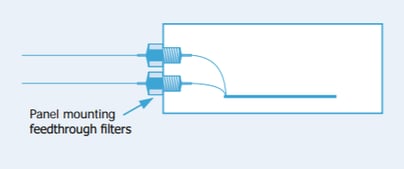 |
| Surface Mount Filter | Surface Mount Filter A filter that is suitable for surface mounting on PCBs.It offers improved filtering compared to standard MLCCs, ease of assembly and savings on board space compared to a combination of discrete filter elements. Filter performance at higher frequencies is reduced compared to panel mount types, unless additional shielding measures are taken.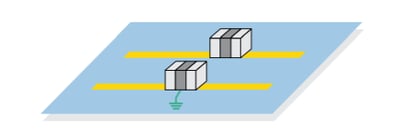 |
| Working Voltage | Continuous operating voltage.This can potentially be across the entire operating temperature range. |
| X2Y Filter | Integrated passive component with extremely low self inductance for filtering and de-coupling. For filtering applications: 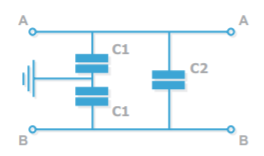 For de-coupling applications: 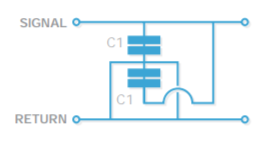 |



















